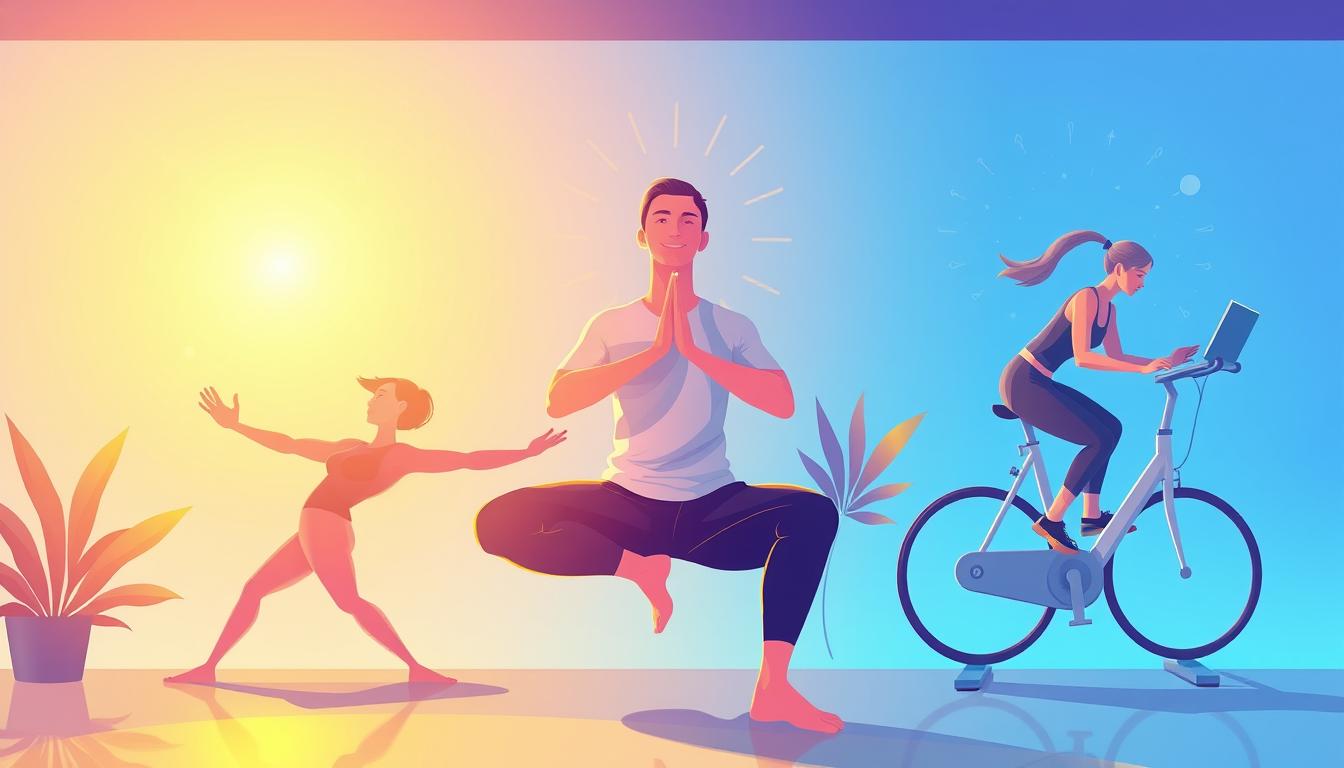Did you know that over 80% of Americans consume caffeine daily, often as a quick fix for fatigue? However, relying on caffeine can lead to jitters, anxiety, and an inevitable crash in energy levels. It’s time to explore energy-boosting techniques that don’t involve caffeine.
Discovering effective methods to boost energy without caffeine can significantly enhance your overall vitality and productivity. This article will delve into various strategies that help you stay energized throughout the day, without the negative side effects associated with caffeine consumption.
Key Takeaways
- Understand the importance of non-caffeinated energy sources.
- Learn simple techniques to enhance your energy levels.
- Explore dietary changes that can impact your energy.
- Discover stress management methods to reduce fatigue.
- Find out how physical activity can boost your vitality.
The Truth About Caffeine and Energy
Many rely on caffeine to increase energy levels, but understanding its cycle is crucial for long-term vitality. Caffeine works by blocking adenosine receptors in the brain, which can lead to increased alertness and energy. However, this effect is temporary and can result in a crash once caffeine is metabolized.
Understanding the Caffeine Cycle
The caffeine cycle refers to the body’s adaptation to regular caffeine intake. As the body becomes accustomed to caffeine, it requires more to achieve the same energy-boosting effects. This cycle can lead to dependency and disrupt natural energy production. Regular consumption can result in withdrawal symptoms when caffeine is not consumed, further complicating its role in energy management.

Why Many People Are Seeking Alternatives
As awareness about caffeine’s limitations grows, many are seeking natural energy sources to boost their vitality. The desire for sustainable energy solutions is driven by the need to avoid caffeine’s negative side effects, such as jitteriness and the inevitable energy crash. Natural alternatives offer a promising path to maintaining energy levels without the risks associated with caffeine dependency.
“The key to sustained energy is not in quick fixes but in adopting a lifestyle that supports natural energy production.”
Setting Realistic Expectations for Natural Energy
Transitioning to natural energy boosters requires setting realistic expectations. Unlike caffeine, which provides immediate but short-lived energy, natural methods work gradually to enhance vitality. Understanding that natural energy sources like nutrition, hydration, and sleep contribute to long-term energy levels is essential for a successful transition.
By recognizing the limitations of caffeine and embracing natural energy solutions, individuals can achieve a more stable and sustainable level of vitality.
Natural Ways to Boost Energy Without Caffeine
Unlock your body’s natural energy potential with these caffeine-free hacks. Boosting energy without relying on caffeine is not only possible but also beneficial for overall health. By incorporating the right foods, hydration strategies, and herbal energizers into your daily routine, you can achieve sustained vitality throughout the day.
Power-Packed Foods That Fuel Your Day
The food we eat plays a crucial role in our energy levels. Consuming the right nutrients can help maintain energy throughout the day.
Complex Carbohydrates for Sustained Energy
Complex carbohydrates, such as whole grains, are digested slowly, providing a steady release of glucose into the bloodstream. This helps maintain sustained energy levels. Examples include brown rice, quinoa, and whole-wheat bread.
Protein-Rich Options to Prevent Energy Crashes
Protein-rich foods like lean meats, fish, and legumes help stabilize blood sugar levels, preventing energy crashes. Incorporating protein into your meals can keep you energized and focused.
Energy-Boosting Vitamins and Minerals
Certain vitamins and minerals, such as iron, vitamin B12, and magnesium, play a key role in energy production. Ensuring adequate intake of these nutrients through diet or supplements can help combat fatigue.
Hydration Strategies for Optimal Energy
Staying hydrated is essential for maintaining energy levels. Even mild dehydration can cause fatigue, headaches, and difficulty concentrating. Drinking enough water throughout the day is crucial, and incorporating hydrating foods like watermelon and cucumbers can also help.
Herbal Energizers and Adaptogens
Herbal energizers and adaptogens offer a natural way to boost energy and resilience to stress. These herbs help the body adapt to physical and mental demands, promoting overall well-being.
Ginseng, Rhodiola, and Other Proven Herbs
Ginseng and rhodiola are well-known adaptogens that can enhance energy and mental clarity. Other herbs like ashwagandha and maca root also offer energizing properties without the side effects associated with caffeine.
How to Incorporate Herbs Into Your Daily Routine
Herbal energizers can be consumed in various forms, including teas, capsules, and powders. Adding them to your daily routine, such as with breakfast or before a workout, can provide a natural energy boost.
Timing Your Meals for Maximum Vitality
Eating at the right times can significantly impact energy levels. Spacing out meals and snacks, and eating a balanced diet, can help maintain stable energy throughout the day.
Physical Techniques for Immediate Energy Boosts
Energize your day with these physical techniques designed to increase vitality instantly. When you’re feeling drained, a quick energy boost can be just what you need to get back on track.
5-Minute Energy-Boosting Exercises
Short bursts of physical activity can significantly enhance your energy levels. Incorporating exercise into your daily routine doesn’t have to be time-consuming.
Desk-Friendly Movement Breaks
Simple stretches and movements at your desk can help increase blood flow and reduce fatigue. Try standing up, stretching your arms overhead, and doing a few leg lifts.
Morning Routines to Start Your Day Energized
Begin your day with a 5-minute morning routine that includes light stretching or a short walk. This sets a positive tone and energizes you for the day ahead.
Afternoon Pick-Me-Up Activities
Take a short walk outside or do a few jumping jacks during your afternoon break. These activities can help combat mid-day slumps.
Energy-Generating Breathing Techniques
Breathing techniques can have an immediate impact on your energy levels. By focusing on your breath, you can calm your mind and invigorate your body.
Box Breathing for Quick Alertness
Box breathing involves inhaling for a count of 4, holding for 4, exhaling for 4, and holding again for 4. This technique can quickly restore alertness.
Energizing Breath Patterns from Yoga
Yogic breathing techniques, such as Kapalabhati or “Breath of Fire,” can be particularly energizing. These involve rapid, forceful exhales followed by passive inhales.
When and How to Use Breathing for Energy
Use breathing techniques during moments of fatigue or stress. Even a few minutes of focused breathing can make a significant difference in how you feel.
The Surprising Energy Benefits of Cold Exposure
Cold showers or exposure to cold environments can be incredibly invigorating. Cold exposure stimulates circulation and can increase your alertness.
| Technique | Benefits | Tips for Implementation |
|---|---|---|
| Cold Showers | Increased alertness, improved circulation | Start with lukewarm water and gradually decrease the temperature |
| Breathing Exercises | Reduced stress, increased energy | Practice regularly, even when not feeling tired |
| Short Exercises | Boosted energy, improved mood | Schedule short breaks throughout the day |
By incorporating these physical techniques into your daily routine, you can enjoy sustained energy levels throughout the day without relying on caffeine.
Lifestyle Foundations for All-Day Energy
Sustained energy is not just about what you do, but how you live your daily life. Creating a lifestyle that supports all-day vitality involves making intentional choices about your daily habits and routines.
Sleep Optimization Techniques
Quality sleep is the cornerstone of sustained energy. Optimizing your sleep involves creating the right environment, timing your sleep correctly, and troubleshooting common sleep issues.
Creating the Ideal Sleep Environment
Your bedroom should be a sanctuary for sleep. Ensure it’s dark, quiet, and at a comfortable temperature. Consider using blackout curtains, earplugs, or a white noise machine if necessary. Invest in a comfortable mattress and pillows to enhance sleep quality.
Sleep Timing and Cycles for Energy
Understanding your sleep cycles is crucial for waking up feeling refreshed. Most adults need 7-9 hours of sleep, with the ideal sleep cycle lasting around 90 minutes. Try to wake up at the end of a cycle to feel more energized.
Troubleshooting Common Sleep Issues
If you struggle with sleep, identify the root cause. Common issues include stress, caffeine, and electronic device use before bed. Establish a relaxing bedtime routine to signal your body that it’s time to sleep.
Stress Management for Energy Conservation
Chronic stress can drain your energy reserves. Effective stress management techniques include meditation, deep breathing exercises, and physical activity. By managing stress, you can conserve energy and enhance overall well-being.
Mental Techniques for Energy Enhancement
Your mental state significantly impacts your energy levels. Techniques such as mindfulness, avoiding energy-draining thought patterns, and visualization can enhance your energy.
Mindfulness Practices That Increase Alertness
Mindfulness practices, such as meditation and mindful breathing, can increase alertness and reduce fatigue. Regular mindfulness practice can lead to sustained energy levels throughout the day.
Energy-Draining Thought Patterns to Avoid
Negative thought patterns can drain your energy. Be aware of and challenge thoughts that are pessimistic or catastrophic. Replacing these with more positive, realistic thoughts can help maintain energy.
Using Visualization for Energy Activation
Visualization is a powerful tool for energy activation. By vividly imagining yourself feeling energized and capable, you can boost your actual energy levels. Practice visualization regularly to enhance its effectiveness.
Designing Your Personal Energy Blueprint
Creating a personalized energy blueprint involves assessing your current lifestyle, identifying areas for improvement, and implementing changes to boost your energy. This tailored approach ensures that you’re making the most effective changes for sustained energy.
By focusing on these lifestyle foundations, you can create a robust framework for all-day energy. It’s about making sustainable changes that enhance your overall well-being and vitality.
Conclusion: Your 7-Day Caffeine-Free Energy Plan
Boosting your energy without caffeine is achievable by incorporating natural ways to boost energy without caffeine into your daily routine. By implementing the strategies outlined in this article, you can increase energy levels naturally and sustain them throughout the day.
To get started, create a 7-day plan that includes power-packed foods, hydration strategies, and physical techniques. For example, begin by incorporating energy-boosting foods like leafy greens and nuts into your meals, and practice 5-minute energy-boosting exercises in the morning.
As you progress, focus on sleep optimization techniques, stress management, and mental techniques for energy enhancement. By the end of the 7 days, you’ll be equipped with a personalized energy blueprint that helps you maintain natural energy levels. Start your journey today and discover the benefits of a caffeine-free lifestyle.
